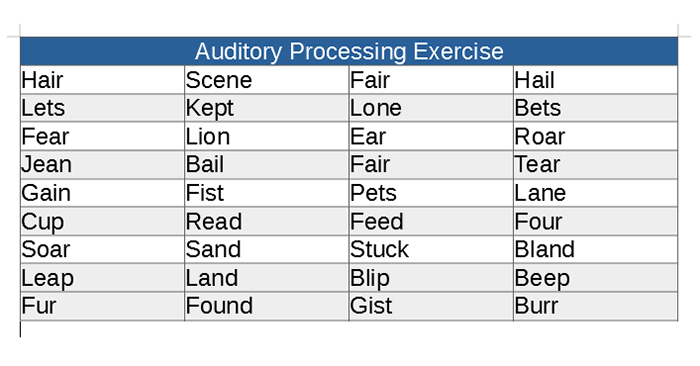
Getting to the Root of the Problem
Every parent wants success for their child.
As a parent, your world may seem to spin out of control when your child struggles.. Especially when you can't put your finger on the problem
First things first. Take a deep breathe and relax. Your mental state is critical for this process. So is your child's.
As a matter of fact, nervous mental states are always a part of the problem. That's why confidence boosting is critical. No matter where the problem started, you will need to build your child's confidence.

Testing the Senses
Visual Processing System
Check if your child is weak in visual processing. Here's an easy test:
Holding a pencil up in front of your child's eyes. Move it side to side slowly. Have your child can follow the pencil with their eyes.
As you do this watch their eyes. Are they moving smoothly? Or do you notice any jumps? If the motion is not smooth this may signify a problem.
![]()
Testing and strengthening eye muscles is an important first step. It's one of the easiest things to correct. And doing so leads to fast results. If you suspect it might be a problem there are many more easy tests and exercises that fix the problem. Visual therapists can do this. Or you can do it at home using the Learning Success System
Weak eye muscles cause visual tracking problems. This will cause difficulty in doing schoolwork. Letters may jump around. Work may be sloppy. Your child may fatigue or get headaches.
The bottom line is that they are working too hard. It should be and can be, easier.
Visual tracking is not the only visual micro-skill. Others include visual memory, visual discrimination, visual closure, and visual form constancy.
These comprise the visual processing system. A weakness in any will lead to academic difficulties. These weaknesses are very common. Possibly because we use screens so much. So it's a good idea to strengthen them in all children. Even if they are not showing problems.
Auditory Processing System
Next is the auditory processing system. Here's an easy test:
Read each line in the exercise to your child. Ask them to repeat back to you the two with the same ending sounds.

How difficult was it? Did they make mistakes? Did they take a long time?
You can also pay attention to where they are looking. If they are looking up and to the right then they are accessing visual memory as well. So they are mentally connecting the auditory with the visual. This is good. That means the auditory and visual systems are working together. If not, that may be something you'll want to work on with them.
If there is a problem here it could lead to
- Poor comprehension
- Following directions
- Slow labored reading
There are several different potential causes for trouble with this exercise. All are auditory processing difficulties. They could be:
- Auditory discrimination
- Auditory closure
- Auditory memory
Or a combination of the above.
It is not important to figure out exactly which. This is because you should work on all of them together. The brain is not a machine in which you can replace one part. Everything works together. So, even if the problem is with a single micro-skill, you should work on all of them together.
The above is a good test to get you started. It's better as an exercise though. Put together exercises like this which cover all of the possible ending sounds. Then do the same with beginning sounds. You might even do middle sounds and multi-syllable words. Or, if you want to make it easy on yourself, you can get all of them in the Learning Success System. Get a free trial here.
What to do now.
The Kinesthetic System
The most often overlooked part of learning is the kinesthetic system. This is very unfortunate because it is the most important. The kinesthetic ties it all together. All learning starts here.
Especially for boys. Boys need a strong kinesthetic system to learn well. In other words, they need to move. Run. Jump. Play.
It's no surprise that there are so many children affected by this. Schools sit them at desks and prohibit movement. One of the worst things you can do for developing learning skills.
When we were teaching Kung Fu daily we saw hundreds of kids improve in academics. The only thing we did was teach them to coordinate their bodies. Nothing more. This alone improved grades. Parents constantly came to us and said "I don't know what you are doing but keep doing it".
It wasn't obvious why this worked. Nobody really knew back then. Including us.
Fortunately, Neuroscience is now revealing why. Science caught up with what we were seeing decades ago. This is why we put so many of these moves in the Learning Success System. Because they are amazing at developing proprioception. Proprioception exercises cause neurogenesis and neuroplasticity. We always knew they worked. Now we know why they work.
A few things you can do to assess your child's kinesthetic system
Check Your Child's Handwriting.
Check if it is legible.
Check if your child spaces words evenly.
Focus on the details of the writing -- are the capital letters larger than the small letters?
Is their handwriting very small or very large?
These handwriting issues can be symptoms of kinesthetic problems.
How about socially?
Does your child often show awkwardness in social settings? It's possible that your child may have trouble learning through demonstration. That would signify a possible weakness in translating visual information into kinesthetic. A very common problem with an easy fix.
Other Signs of Proprioception Difficulty
Did your child have difficulty learning to tie their shoes?
Learning left and right?
Learning certain coordination exercises like jump rope or hopscotch?
These all have roots in the kinesthetic system. Doing proprioceptive exercises will help your child immensely.
Key Takeaways:
Despite the instinct to simply tell your child to "try harder" in these areas, it usually doesn't get the job done.
In many cases, they might believe they are trying harder. They probably want to do well in school, too.
You can help them. By identifying what their weakness is and fixing it.
There are a few schools in the US that have on-staff occupational therapists that are trained in this area. Unfortunately, these schools are few and far in between. And even if you have access to such a school the occupational therapists are not able to do much one one one with your child. Because of time constraints they have to work in a group setting and can't really focus on each child's needs individually. Fortunately, now that this information is easily available, this can be done at home very easily with the Learning Success System
Learning difficulties can be a devastating life sentence. They don't have to be. Good parenting can get a child through it and teach them to excel.
Setting your child up for success is one of the best things you can do as a parent.
Do You Need help with a Learning Difficulty?
Our simple online analysis will help you get to the core of the problem and find the right solution for you.
Understanding how to help someone with a learning difficulty starts with understanding which micro-skills are affected. When you learn which of the micro-skills is the problem, you will then be on your way to solving it.
You'll also learn how to:
- Build confidence
- Enhance Learning ability
- Eliminate avoidance
- Build grit
You can get this analysis for free by filling out this simple form. This will help you get to the bottom of a learning difficulty and provide you with a solution. If you are ready to put this problem behind you click the button below and fill out the form.












